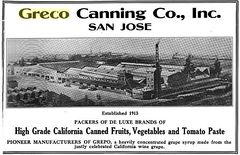Greco Canning Company
| Business |
Cannery |
|---|---|
| Main Location |
San Jose, CA |
| Active |
1913-1938 |
| Brands |
De Luxe, Korona, Alta Villa (1919) |
| Predecessors |
Santa Clara Valley Canning Company |

Greco Canning was a San Jose canner that operated on Autumn Street from around 1913 through 1938 run by Victor Greco. The company bought the Santa Clara Valley Canning Company's "three-line" cannery on Taylor Street in 1921[1][2]. In 1920, Greco Canning was run by Victor Greco (president and general manager), with Nicholas Greco as secretary[3]
Greco was the world's largest tomato canner during World War II[4] and "one of the largest canners of string beans". The company also made Grepo, a processed grape syrup. They started by selling primarily to the "Latin" market. They also manufactured tomato paste products, with Edith Daley commenting on their boiler for making toms-butter (tomato paste) being "big enough to boil Lake Michigan, Saginaw included!"[5].
The company ceased operation in 1938. It may have restarted in 1941 only to be sold to the Almaden Packing company in 1945, which was organized only to buy Greco.[6] (A later source claimed that Greco was sold to Mission Valley Canning Company in September 1953[7].) The plant later became the home of the Mission Valley Canning Company.
A 1920's employee photo in the Greco Family Archive on Facebook shows that the warehouse for the cannery was being operated by the Lawrence Warehouse Company.
Greco was one of the early tomato paste producers in the Santa Clara Valley. His initial attempt in 1916 failed because of problems with the machinery. The details of the problems were documented in a 1920 lawsuit by P. Pastene and Company over Greco's failure to deliver promised tomato paste in the 1916 season[8][9].
Locations
| Location | Years | Address | Details |
|---|---|---|---|
| San Jose | 1913-1945 | Howard and Autumn |
Photos
Greco Canning Co., San Jose John C. Gordon Collection / San Jose Library
Details
SP Valuation Map shows grant from City of San Jose to Greco Canning to cross Autumn Street, signed 1928.
References
- ↑ Cannery Notes: October 1922 Canning Age
- ↑ Greco People Buy Big 'Three Line' Cannery: September 18, 1922 San Jose Evening News. 'from a small beginning in 1913 to a point where it is now the largest canner of string beans in California, and the largest independent packer of tomato products on the west coast.'
- ↑ Greco Canning Company: California Food Products Directory. 1920.
- ↑ Frederick W. Marrazzo, Italians in the Santa Clara Valley, Arcadia Publishing, 20xx.
- ↑ Toma-Butter Soon to Appear on Every Table: August 2, 1919 San Jose Evening News
- ↑ Greco Canning Property Sold: Jan. 2, 1945 San Jose Evening News
- ↑ September 1953 Western Canner and Packer
- ↑ Greco Canning Company , plaintiff-in-error vs. P. Pastene and Co., defendant-in-error, September 15, 1922, U.S. Court of Appeals for the Ninth Circuit. . No. 3750. The testimony notes that tomato paste was not manufactured in the U.S. before 1916. Italy placed an embargo on exporting tomato paste that year. Some of the problems in the pack were caused by problems with the new and unusual tomato paste machinery purchased from the Oscar Krenz Manufacturing Company. Greco also testified that Pastene had visited the plant and walked through with Greco before signing the fatal contract.
- ↑ Robert Bowdidge, The Tomato Paste Land Rush. On [1]